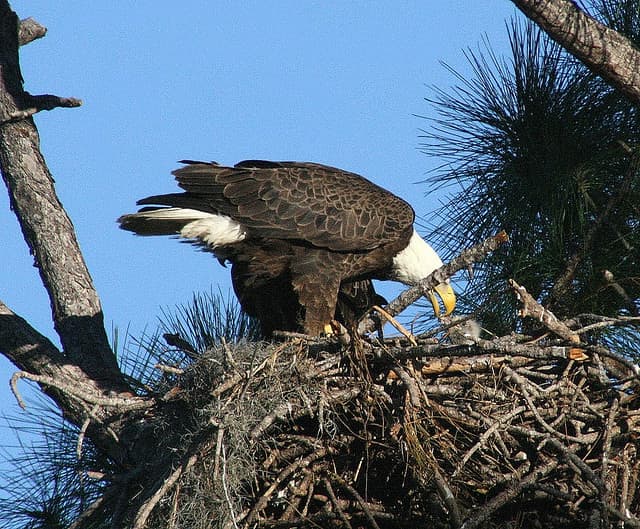Eaglets Provide Rare Sight at Swan Island Wildlife Management Area
OutdoorHub 07.28.11

RICHMOND, Maine – A pair of nesting bald eagles at the Swan Island Wildlife Management Area have produced the first documented occurrence of four eaglets in a single nest in the history of the State of Maine, according to wildlife biologists from the Maine Department of Inland Fisheries and Wildlife.
“This pair has produced a new milestone for eagle recovery in Maine,” said MDIF&W wildlife biologist Kendall Marden, who manages Swan Island. “After two years of unsuccessful nesting attempts, this year the pair successfully hatched four eaglets. It’s a remarkable event.”
There are believed to have been only three other documented cases of four eaglets in a single nest in the United States.
As recently as 40 years ago, bald eagles were battling against extinction. Widespread use of the pesticide DDT was implicated in detrimental impacts to wildlife, especially birds of prey. The nation’s bald eagle population had plummeted to all-time lows, due in large part to excessive levels of DDE. This byproduct of DDT caused precariously thin eggshells that were unable to endure nesting attempts. Nesting pairs in Maine numbered around 20 and things looked bleak.
Recovery efforts were initiated and protection was implemented.
Early management efforts included transplanting healthy eggs from remaining bald eagle strongholds, as well as introducing captive hatched eaglets into nests. One such nest that was afforded these attempts was located at the Swan Island Wildlife Management Area on the Kennebec River near Richmond. An egg from Wisconsin was transplanted in 1975 and the nesting pair successfully raised an eaglet.
Swan Island is a good example of one of the main objectives used in eagle recovery – the protection of nests. Protection of some 300 nests across Maine has been achieved through ownership and easements by many partners. Swan Island wildlife management area is owned by the Maine Department of Inland Fisheries and Wildlife, and the three active nesting sites located within its bounds are permanently protected.
In 2007, the bald eagle was removed from Maine’s list of threatened and endangered species, with more than 500 nesting pairs in the state today.
“While the bald eagle’s status isn’t quite as tenuous as it was years ago, it still remains exciting to see new milestones in their continued resurgence,” Marden said. “Four eagles in one nest is quite a crowd. Hopefully, they survive to spread out into new territories throughout the state and the northeast.”
Eagles begin breeding at about five years of age but can live to be nearly 30 years old. Adult pairs show strong fidelity to nesting areas, making it important to protect nesting sites, even if they are not successful each year. Suitable areas can remain inhabited as pairs come and go over the decades.
“The adult eagles at Swan Island have done their part so far in ensuring survival of all four eaglets, but it’s nearing the time the young will have to be more independent,” Marden said. “Over the next several weeks they will learn to fly and feed on their own. This is one of the critical time periods in an eagle’s life.”
If eaglets can survive until they learn to fly completely, their chances of surviving their first year reaches 75 percent. Once eagles reach three years of age, their annual chances of survival are at their highest at around 95 percent.

